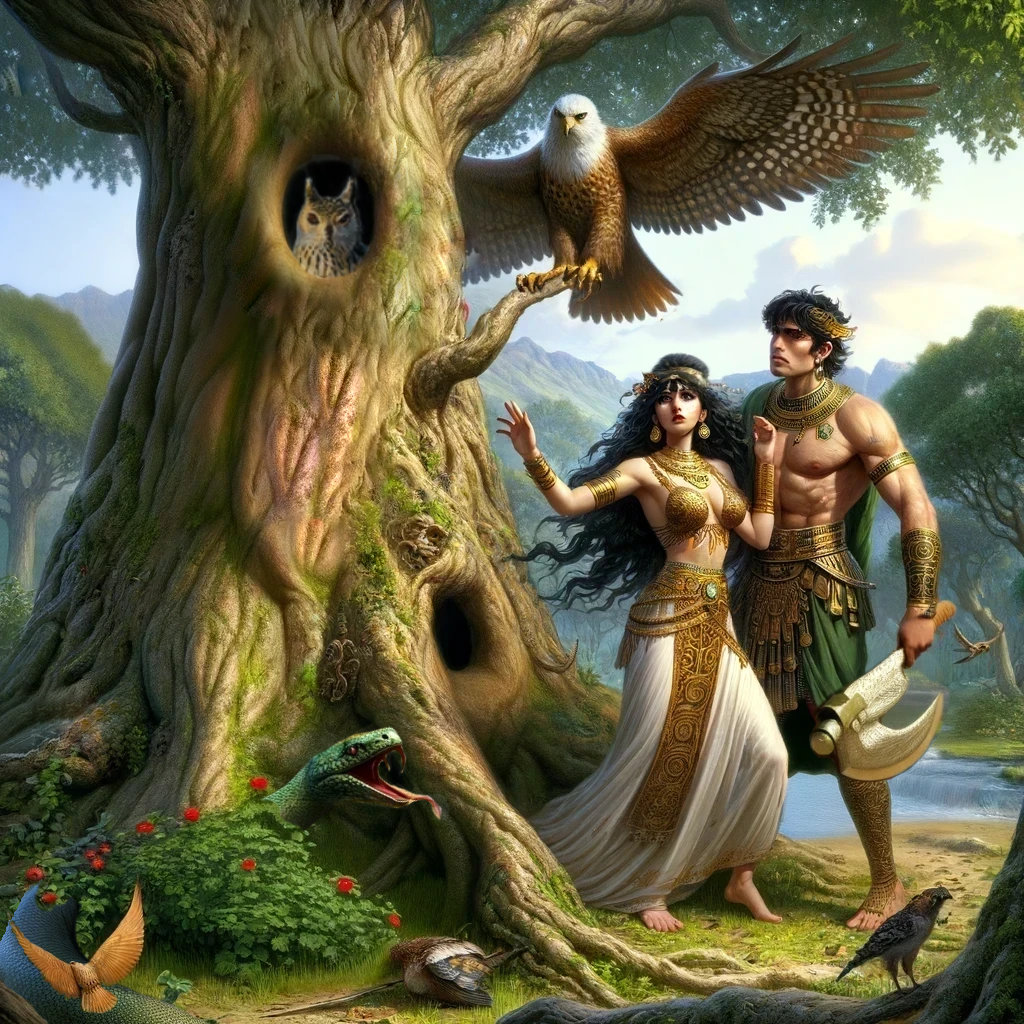In the first days, in the very first days,
in the first nights, in the very first nights,
in the first years, in the very first years,
in the first days, when everything that was necessary had been created,
in the first days, when everything that was necessary was properly nurtured,
when bread was baked in the shrines of the land
when bread was tasted in the homes of the land,
when the sky had moved away from the earth,
when the earth was separated from heaven,
when the name of man was fixed,
when An had taken the sky,
when Enlil had taken the earth,
when the Queen of the Great Below, Ereshkigal,
was given the netherworld for her domain,
at that time, a tree, a single tree
was planted on the banks of the Euphrates.
Enki, the father, planted the Huluppu tree.
The god of wisdom planted it on the banks of the Euphrates,
before the waters of the Euphrates drew Enki into the sea,
before his boat was pulled down towards the netherworld.
The tree was nourished by the waters of the Euphrates,
the very waters that carried Enki into the sea.
Small wind stones were tossed against his boat.
Large hailstones were hurled up against him,
like approaching turtles.
They threw themselves onto the keel of Enki's boat.
The keel of Enki's boat was overwhelmed
in the fight against the attacking storm.
The water at the head of the boat devoured the king like a wolf.
The water at the rear of the boat stroke Enki down like a lion.
The swirling south wind rose up and blew against the tree.
It tugged at its roots, it tore at its branches,
until the waters of the Euphrates carried the tree away.
The young woman Inanna,
who walked in fear of no man
and did not want to be owned,
who wandered around anxiously at the word of An,
who wandered around anxiously at the word of Enlil,
pulled the tree out of the river and brought it to Uruk.
(It is possible that the windstones refer to throwing stones and the hailstones to arrows made from reed. That paragraph was intentionally written ambiguously by the author)
Inanna pulled the tree out of the river and spoke:
"I will bring this tree to Uruk. I will plant it in my sacred garden."
Inanna tended the tree with her hand. She firmed the earth around the tree with her foot. She asked herself:
"How long will it be before I have a shining throne to sit on? How long will it be before I have a luscious bed to lie on?"
The years passed: five years, then ten years. The tree grew thick. Its trunk did not branch out. Then a serpent who could not be charmed built its nest in the roots of the tree. The Anzu bird placed its young in the branches and the dark maiden Lilith built her house in the trunk.
The young woman, who loved to laugh, cried. How Inanna cried! But they didn't want to leave her tree.
When the birds began to sing at dawn, the sun god Utu left his royal bedchamber. Inanna called to her brother Utu and said:
"O Utu, in the days when the fates were decreeed, when the land blossomed in abundance, when the territories of the great gods were divided and Enki's boat was pulled down to the netherworld, I pulled the Huluppu tree out of the Euphrates, planted it in my holy garden and tended it while I waited for my shining throne and my luscious bed.
Then a serpent who cannot be charmed nested in the roots. The Anzu bird placed its young in the branches, and the dark maiden Lilith built her house in the trunk. I wept. And how I wept! But they won't leave my tree."
Utu, the brave warrior Utu, did not want to help his sister Inanna.
Who could help Inanna in her quest for domination? It could only be a hero on a quest, Gilgamesh, the hero of Uruk. When the birds began to sing at the second dawn, Inanna called the hero Gilgamesh and said:
"O Gilgamesh, in the days when the fates were decreeed, when the land blossomed in abundance, when the territories of the great gods were divided, then I pulled the tree from the Euphrates, then I planted it in my holy garden and tended it, and since then I have waited for my shining throne and my luscious bed.
Then a serpent that cannot be charmed nested in the roots. The Anzu bird placed its young in the branches and the dark maiden Lilith built her home in the trunk. I cried, and how I cried! But they won't leave my tree."
Gilgamesh, the brave warrior, Gilgamesh, the hero of Uruk, stood by Inanna's side. Gilgamesh strapped his armor, which weighed fifty mina, around his chest. The fifty mina weighed as little to him as fifty feathers. He lifted his bronze axe, the axe of the road, which weighed seven talents and seven minas, to his shoulder. He entered the holy garden of Inanna.
Gilgamesh slew the serpent, who refused to be charmed. The Anzu bird flew into the mountains with its young, and Lilith smashed her house and fled into the wild, uninhabited regions.
Gilgamesh then loosened the roots of the tree, and the sons of the city who accompanied him cut off its branches. He gives the tree to the holy Inanna for her throne, gives it to her for her bed. Inanna forms its roots into a pukku for him,
forms its crown into a mikku for him, the hero of Uruk.
Gilgamesh played the pukku in the wide square in Uruk and never wanted to stop playing it. He praised himself on the wide court and never wanted to stop praising himself.
The young men of his town played (danced?) to the pukku. Everyone who played in the widow children's team lamented, "O my neck! O my hips!" For the one who had a mother, the mother brought bread for her son. For the one who had a sister, the sister brought water for her brother.
When evening came, Gilgamesh marked the spot where the pukku had been placed, picked up the pukku in front of him and took it home. But early in the morning, when he went to the marked place, the widows accused him and the young girls complained. His pukku and mikku fell through a hole to the bottom of the underworld.
Gilgamesh put in his hand, but could not reach them. He put in his foot, but could not reach them. He sat down at the great gate Ganzer, the entry to the netherworld. Gilgamesh wept, his face turned pale.
The myth is designed as an intelligence test. The reader is supposed to find out that the felling of the tree was unjust, identify the dance epidemic as the punishment imposed, and with the knowledge he has from other myths, find out who imposed the punishment.
The Huluppu Tree was always at the center of power. At first it stood in Eridu, but when Eridu fell, or was flooded, it was brought to Uruk. The tree is therefore a magical tool that the gods needed to create the Sumerian civilization.
Since the reigns of the kings of Uruk declined sharply after the tree was felled, it can be assumed that the tree gave the early kings a long life. The tree can therefore also be called the tree of life. It received its function from the three demons that lived in it: the eagle Anzu, the incorruptible serpent and the dark maiden Lilith.
The fact that Utu, the god of justice, had refused to cut down the tree for his sister Inanna means that it was unjust to cut it down. Cutting the tree down was unjust because it was the home of the three demons who were commissioned by the gods to accomplish the things they were told to do.
The Anzu bird was commissioned by Enlil to decree human fates (according to the myth Lugalbanda and the Anzu Bird. He took revenge on those who cut down the tree by decreeing their fates. He decreed that Gilgamesh could not stop playing on his pukku and that the young men of the city who had cut off the branches of the tree could not stop dancing to it until they died of exhaustion. This resembles the dance epidemics of the Middle Ages. The reason for this unusual punishment may be that Anzu can only decree good fates. He decreed the good fate of dancing in such a way that it included the bad fate of dying. Anzu could not influence Inanna's fate because she was a goddess.
Since the pukku was created from the roots of the tree, which presumably reached to the underworld, a hole finally opened in the ground and the pukku fell into the netherworld.
Inanna needed the throne and the bed that she had made from the trunk of the tree to consolidate her power. In particular, the bed was later used for the sacred marriage ritual, the core of which was an act of sexual encounter between the king and the goddess Inanna. Inanna probably hoped to be able to influence the king in his decisions.


